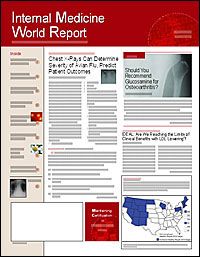IDEAL: Are We Reaching the Limits of Clinical Benefits with LDL Lowering?
From the American Heart Association
Dallas?The limits to the clinical benefits of lowering low-density lipoprotein (LDL) cholesterol may be close at hand. In a new trial comparing the use of high-dose atorvastatin (Lipitor) with moderate-dose simvastatin (Zocor) in patients with stable coronary heart disease (CHD), the aggressive LDL-lowering strategy did not impart a significant advantage over the less aggressive strategy in reducing the number of major coronary events, including acute myocardial infarction (MI), said Terje R. Pedersen, MD, professor of medicine, Ulleval University Hospital, and director of the Center for Preventive Medi?cine, Oslo, Norway, at the American Heart Association's Scientific Sessions 2005.
However, several secondary end points did show benefit with the aggressive stra?tegy, including the number of any cardiovascular (CV) or CHD event. In addition, the study provided further proof of the safety of high-dose statins.
In this trial, known as IDEAL (Incre?mental Decrease in Clinical End?points Through Aggressive Lipid Lower?ing), the use of high-dose atorvastatin was associated with a nonsignificant 11% re?duction in major coronary events after nearly 5 years compared with the use of low-dose simvastatin for the same duration.
In IDEAL, 8888 patients with stable CHD were randomized to atorvastatin, 80 mg/day, or simvastatin, 20 mg/day, which could be titrated to 40 mg/day if either total cholesterol remained >193 mg/dL or LDL cholesterol remained >115 mg/dL.
The regimen of simvastatin used in IDEAL was one established previously by the Scandinavian Simvastatin Survival Study (also known as 4S), which showed that the drug provided significant clinical benefits compared with placebo, said Dr Pedersen.
In IDEAL, the primary end point was a composite of MI, CHD death, or cardiac arrest with resuscitation, the rate of which was not significantly different between the 2 treatment groups (Table).
Several secondary end points, however, did show benefit with the high-dose regimen. Patients randomized to high-dose atorvastatin had a 13% reduction in major CV events (P = .02), a 16% reduction in any CHD event (P < .001), and a 16% reduction in any CV event (P <.001).
IDEAL provided some comfort that high-dose statin therapy is safe. In the Treat to New Targets study, high-dose atorvastatin was associated with a trend toward an increase in non-CV mortality compared with moderate-dose pravastatin (Pravachol). In IDEAL, there was a trend toward fewer non-CV deaths in the atorvastatin group. The 2 trials taken together show that high-dose atorvastatin is not detrimental in any way," said Dr Pedersen.
With the new evidence that high-dose statin therapy is safe, and with previous evidence showing an efficacy advantage, Dr Pedersen said he expects that more clinicians will use high-dose statins in their practice. The study results were also published simultaneously in the Journal of the American Medical Association (2005; 294:2437-2445).
The benefits of high-dose statin therapy may not show up in fewer deaths, he said, because mortality in patients with acute coronary syndromes has been reduced dramatically by the widespread use of revascularization procedures. The mortality rate in IDEAL was only 1% per year, he noted, calling it "outstanding."
He added, "It will be hard for any particular drug to demonstrate further reductions in cardiovascular mortality."
In agreement was Steven Nissen, MD, medical director of the Cleveland Clinic Cardiovascular Coordinating Center. "We're reaching the limits of what LDL reduction can achieve. What you see in the clinical trials is that lower levels of cholesterol provide some benefit?but it's not always statistically significant," he said. "I tell my patients that we'll lower their cholesterol as low as we can get it without producing adverse effects."
According to Allen J. Taylor, director, cardiology service, Walter Reed Army Medical Center, Washington, DC, an LDL-cholesterol?lowering strategy is a starting point, but overall a partial therapy approach. "Clinicians have been waiting for the story on ultra-low LDL cholesterol to unfold," he said. The belief was that we just needed to get LDL cholesterol low enough, and that would finally give us the answer that would control CHD risk. In the end it's a single risk factor in a multifactorial disease.
During the meeting, Dr Taylor presented data from another study showing that adding extended-release niacin to a statin is associated with regression of atherosclerosis.
